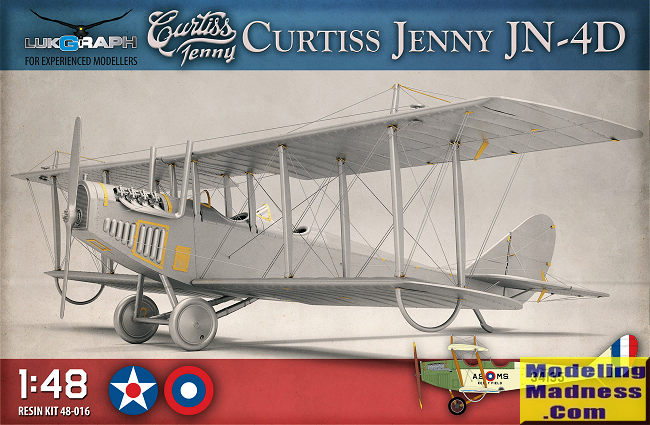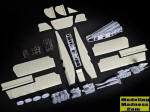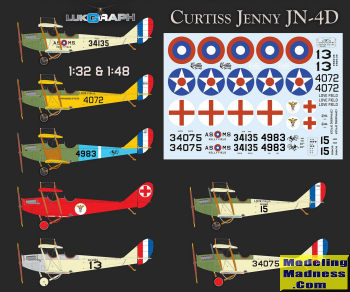
| KIT #: | 48-016 |
| PRICE: | 109.00 Euro |
| DECALS: | Seven options |
| REVIEWER: | Rob Hart |
| NOTES: |

| HISTORY |
The Curtiss JN-4D “Jenny” was a two seat biplane that became the most important and widely used primary trainer used by the United States Army Air Service in WWI. The prototype first flew in June of 1917. The JN-4D differed from previous variants in the JN series by having reduced dihedral, cutouts in the lower wings at the fuselage, and stick type controls. By war's end , 2812 JN-4Ds had been built by six different manufacturers. Other than a few sold to the Post office Department, the government made little use of the JN-4D after the war. However, thousands were sold on the civilian market where, unhampered by regulations and government control, they were used by barnstormers for stunt flying and aerobatic displays. Some civilian Jennys were still flying into the 1930s.
| THE KIT |
 The
Polish company, Lukgraph, has released a mixed media 1/48 scale kit of the
JN-4D. Previous 1/48 “Jenny” kits were initially released by Lindberg and Aurora
in 1955 and 1956 respectively. The Lukgraph kit has resin, 3D printed, and
photo-etched parts. The resin parts cover the fuselage halves and the flying
surfaces. They are crisply cast with both raised and engraved surface details as
appropriate. All of the control surfaces are cast separately. The wings have
steel pins cast integrally and running lengthwise to prevent them from sagging
over time ( a common failing with resin kits). The wings also have holes drilled
in their root ends where they connect with the fuselage to facilitate inserting
metal pins. The fuselage halves are also drilled in corresponding locations. 3D
printed parts are provided for the cockpit, interior framework, propellers,
wheels/tires (both covered and spoked wheels are provided), engine, exhaust
pipes, struts, radiator, and fuselage panels. The strut ends are drilled out to
facilitate inserting steel pins for making positive attachments to the wings and
fuselage surfaces. The instructions show the 3D parts in bright blue to make
them easier to distinguish and remove from their supports. The 100+ photo-etched
brass parts are used for seat belts, windshield frames, control horns, wing
walkways, various cockpit fittings, engine fuel lines, cowl straps, instrument
bezels, strut location points, and forward fuselage panels. A small piece of
clear acetate(or similar) and a length of .5mm steel rod is also provided.
The
Polish company, Lukgraph, has released a mixed media 1/48 scale kit of the
JN-4D. Previous 1/48 “Jenny” kits were initially released by Lindberg and Aurora
in 1955 and 1956 respectively. The Lukgraph kit has resin, 3D printed, and
photo-etched parts. The resin parts cover the fuselage halves and the flying
surfaces. They are crisply cast with both raised and engraved surface details as
appropriate. All of the control surfaces are cast separately. The wings have
steel pins cast integrally and running lengthwise to prevent them from sagging
over time ( a common failing with resin kits). The wings also have holes drilled
in their root ends where they connect with the fuselage to facilitate inserting
metal pins. The fuselage halves are also drilled in corresponding locations. 3D
printed parts are provided for the cockpit, interior framework, propellers,
wheels/tires (both covered and spoked wheels are provided), engine, exhaust
pipes, struts, radiator, and fuselage panels. The strut ends are drilled out to
facilitate inserting steel pins for making positive attachments to the wings and
fuselage surfaces. The instructions show the 3D parts in bright blue to make
them easier to distinguish and remove from their supports. The 100+ photo-etched
brass parts are used for seat belts, windshield frames, control horns, wing
walkways, various cockpit fittings, engine fuel lines, cowl straps, instrument
bezels, strut location points, and forward fuselage panels. A small piece of
clear acetate(or similar) and a length of .5mm steel rod is also provided.
The kit provides 7 decal options. They are:
 2 x USAAS in
clear doped linen with olive drab cowls and early style roundels on top of upper
wing and bottom of lower wings and red white and blue vertical stripes on the
rudder
2 x USAAS in
clear doped linen with olive drab cowls and early style roundels on top of upper
wing and bottom of lower wings and red white and blue vertical stripes on the
rudder
1 x USAAS in clear doped linen with light gray cowl and early style roundels on top of upper wing and bottom of lower wings and red white and blue vertical stripes on the rudder
1 USAAS in clear doped linen with olive drab cowl and white star with central red dot on blue circle on top of upper wing and bottom of lower wing and red white and blue vertical stripes on the rudder
1 Medical plane in overall red with red crosses in white circles on tops of upper wings, bottoms of lower wings, and both sides of the rudder.
1 USAAS with olive drab forward fuselage, light blue rear fuselage, and yellow wings and tail surfaces. Blue circle with white star and red dot on upper surfaces of top wing with early style roundels on bottoms of lower wings and red, white, and blue vertical stripes on rudder.
1 USAAS overall yellow with olive drab forward fuselage and blue circle with white star and red dot on top of upper wings and bottoms of lower wings. Red, white, and blue vertical stripes on the rudder.
Decals are provided for the gauge faces. The thirteen page color instruction booklet also provides a diagram to set the dihedral and comprehensive rigging directions.
| CONCLUSIONS |
This is one of the most complete model airplane kit packages that I have seen. I'm certain that every detail visible to the naked eye has been included. I'm equally certain that it will not be an easy model to build. The manufacturer does make an effort to ease the building process by providing pre-drilled holes at mating surfaces, very clear instructions, and diagrams, and numerous tips and measurements. I wouldn't recommend the kit for anyone's first biplane model , but an experienced builder should be able to turn out a striking replica of the best known North American airplane from WWI.
Rob Hart
March 2024
Copyright ModelingMadness.com. All rights reserved. No reproduction in part or in whole without express permission from the editor.
If you would like your product reviewed fairly and fairly quickly, please contact the editor or see other details in the Note to Contributors.